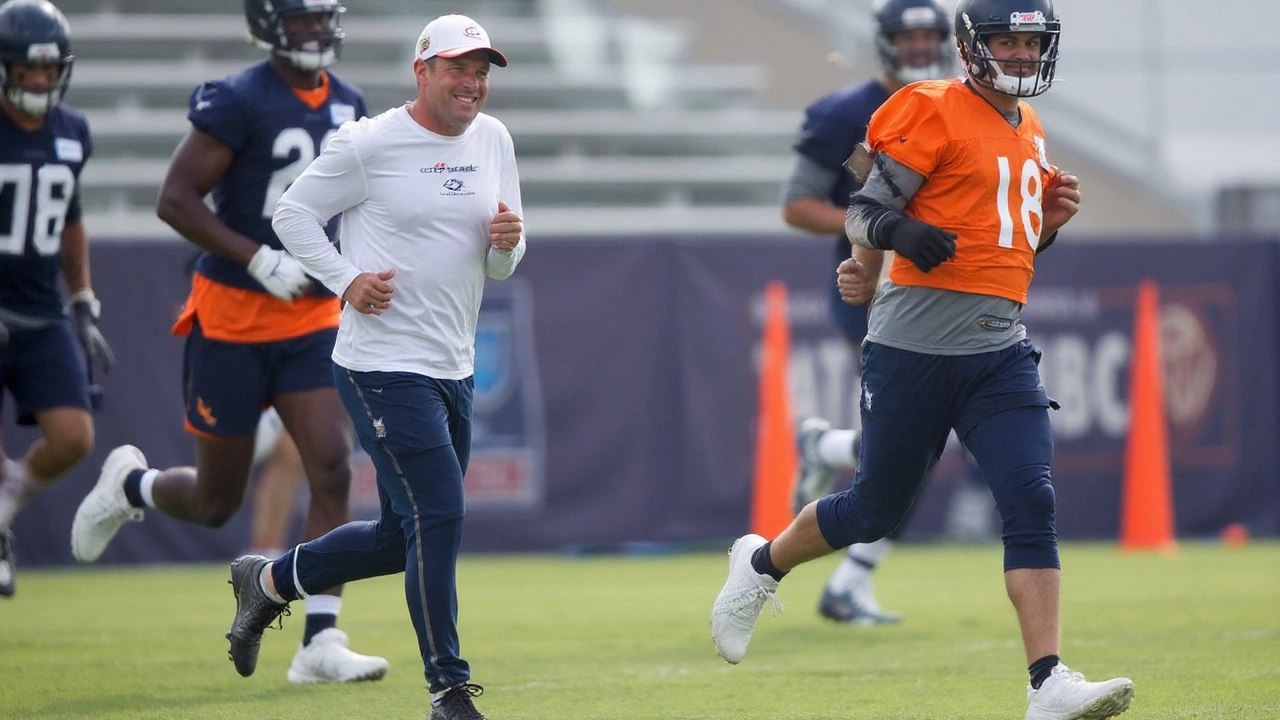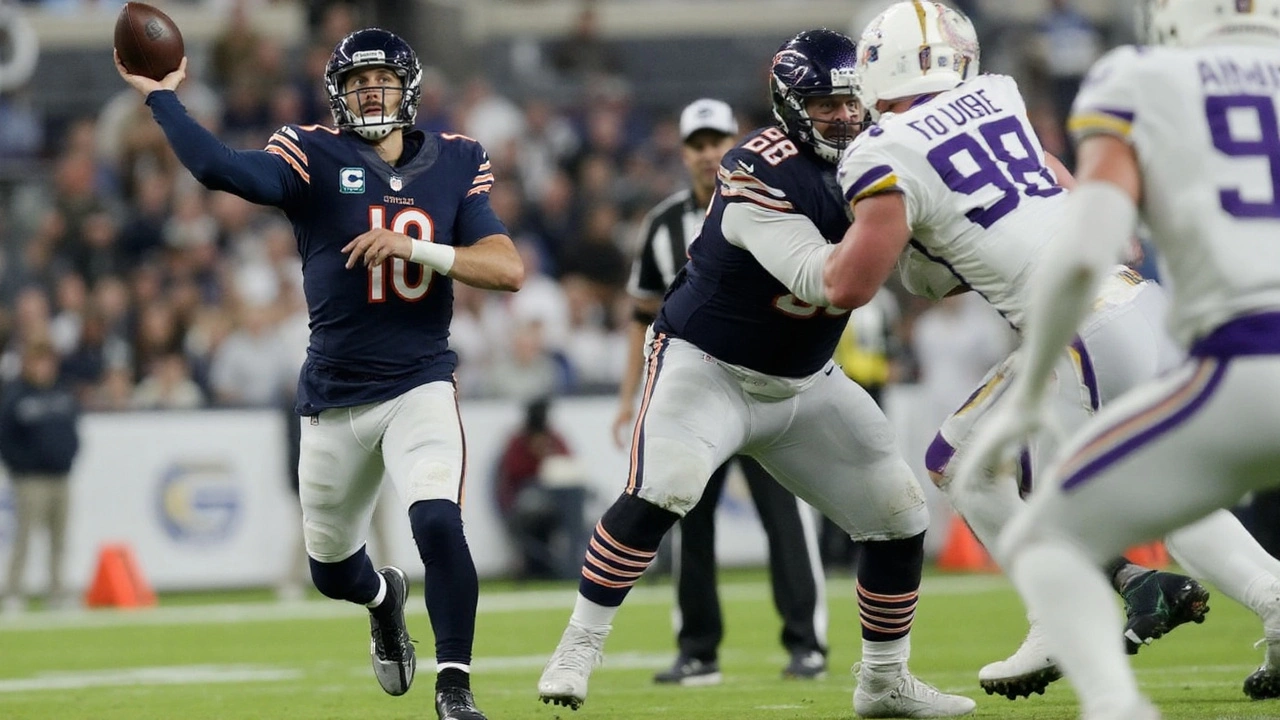Rookie duel under the lights: Vikings flip the script late at Soldier Field
Down 11 points with a quarter to play, the Minnesota Vikings asked a rookie to rescue them on the road. He did. In his first NFL game, J.J. McCarthy led three fourth-quarter touchdown drives and sealed a 27-24 comeback over the Chicago Bears on Monday Night Football, turning a quiet debut into a statement night.
Chicago had controlled the pace for most of the evening. Caleb Williams, in his second season and first under new head coach Ben Johnson, opened sharp and decisive. He completed his first 10 throws and mixed quick-game timing with designed movement, nudging the Bears to a 10-6 halftime lead. The script looked polished. The operation was clean. Soldier Field felt comfortable for the home team.
The third quarter only strengthened that feeling. Chicago’s defense took away Minnesota’s early rhythm, squeezing the run and forcing the rookie to make tight-window throws. When Bears cornerback Nahshon Wright jumped a route and streaked 74 yards for a pick-six, the stadium shook. The lead stretched to 17-6. The Vikings’ sideline went quiet for a beat.
That’s when Minnesota’s approach changed. The Vikings sped up the tempo, leaned into motion, and gave McCarthy clearer pre-snap pictures. Justin Jefferson, shadowed most of the night, finally found space on a deep cross and later a red-zone option where McCarthy’s eyes froze the safety. The first touchdown cut the deficit to four and reset the mood.
From there, Minnesota’s defense joined the rally. Coordinated pressure started to bother Williams. The Vikings crowded the line, disguised late rotations, and brought heat off the slot. Chicago’s drives stalled with longer third downs, and the explosive plays that came early evaporated. Field position tilted purple.
McCarthy then delivered his sharpest series of the game. He worked underneath to keep ahead of the sticks, hit Jefferson on an out that beat tight coverage, and used play-action to slip Aaron Jones into space. Jones finished that march with a touchdown reception, and suddenly Minnesota led. It wasn’t flashy. It was clinical.
The go-ahead score arrived with less than three minutes left, a 14-yard keeper that punished man coverage. The Vikings spread the formation, sold outside zone, and McCarthy kept it, knifing through a crease on the right side. For a rookie who had just thrown a pick-six, it was a veteran call and an even cooler finish.
Chicago still had a punch to throw. Williams engineered a late response, pushing the Bears quickly into scoring range and trimming the deficit to three. But Minnesota’s defense took away the sidelines and kept everything in front, bleeding the clock and forcing underneath completions. The rally held.
For the Bears, this stung because so much went right early. Johnson’s opening script fit his quarterback: quick reads, defined throws, and the occasional designed run to keep the Vikings honest. Williams opened the scoring with a nine-yard touchdown run and looked comfortable managing the pocket. The protection was sound in the first half, and the run-pass balance forced Minnesota to defend every blade of grass.
The second half brought a different reality. The Vikings shifted to heavier pressure looks on obvious passing downs, bracketed Chicago’s top receiving threats, and challenged the Bears to win one-on-one across the board. The rhythm that came easy early became a grind. Red-zone efficiency slipped. A pair of penalties hurt field position at the worst times. Those small dents added up when the game flipped into a one-score battle late.
McCarthy’s debut will draw headlines because of the timing and difficulty of his plays. After the interception, he didn’t shrink. He attacked leverage, took what the defense gave, and hit his layups before hunting shots. His two fourth-quarter touchdown passes—one to Jefferson, one to Jones—showed pace and patience. He trusted his feet when the pocket got muddy. The designed run for the lead showed that Kevin O’Connell was comfortable letting the rookie decide a prime-time game with the ball in his hands.
Williams’ night will read differently, but there’s a lot for Chicago to keep. The quick-start accuracy wasn’t a blip. The pocket movement was smooth. He showed command at the line and the poise needed to re-mount a drive with the game slipping. The late push won’t erase the loss, yet it’s part of the foundation Johnson is trying to build: clear answers, timely aggression, and an offense that doesn’t freeze when a veteran defense turns up the heat.
Key moments that swung the game:
- Nahshon Wright’s 74-yard pick-six: the Bears’ 11-point cushion changed Minnesota’s urgency and sparked the Vikings’ adjustments.
- Jefferson’s fourth-quarter touchdown: Minnesota’s star finally broke free, and McCarthy hit him in stride to ignite the rally.
- Aaron Jones’ red-zone score: a simple release turned into a leverage win and the Vikings’ first lead since early snaps.
- McCarthy’s 14-yard keeper: the decisive call against man coverage sealed a three-touchdown fourth quarter for the rookie.
On defense, Minnesota’s halftime tweaks told the story. Early, the Vikings played more straight and kept a lid on explosives. Late, they forced Chicago into longer drives and muddier reads. Chicago’s counterpunch—screens, quick hitters, and a steady dose of intermediate in-breakers—worked in stretches, but negative plays and late-down stress stacked up.
Chicago’s defense did plenty right, too. The pick-six was earned, not gifted. The front controlled the run for most of three quarters and kept Minnesota behind schedule. The frustration is that the final 15 minutes erased three solid quarters of field position discipline and tackling. One broken leverage, one missed fit, and one late scramble can undo a night’s work. That is the thin margin in prime time.
For the Vikings, this win gives them a proof of concept. The offense doesn’t need 60 minutes of fireworks if it can summon 15 minutes of precision when it counts. Jefferson looked like himself when it mattered. Jones’ versatility paid off. The line protected better late than early. And the rookie didn’t blink. You can build on that.
For the Bears, the tape is going to be blunt. Johnson’s plan worked until Minnesota forced uncomfortable answers. The fixes aren’t abstract: handle pressure better on third down, finish red-zone trips, and eliminate the drive-killing penalties. If Chicago keeps the clean operation Williams showed early and stacks it deeper into games, they’ll win plenty.
One more note: this was Williams’ first home game under Johnson, and the fit looked real for long stretches. The tempo was right. The spacing made sense. The designed quarterback run that opened the scoring was a smart touch. The pain came later, in the details—blitz pickup, spacing versus bracket coverage, and a couple of snaps where the ball came out late. Those are correctable.
It’s Week 1. No banners get raised for September comebacks, and no seasons collapse on opening night. But first impressions matter. Minnesota got one from a rookie quarterback who turned a mistake into a launchpad. Chicago got one from a young passer who looked ready for the stage and a new coach whose plan mostly hit—until it didn’t.

Second screens, watch-alongs, and how fans followed the finish
This game didn’t just live on the broadcast. It lived on phones and laptops. Multiple live watch-alongs streamed from 6:15 PM CDT, pulling in fans with play-by-play reactions, chalkboard breakdowns, and rapid-fire chat. Viewers used them as second screens—one eye on the TV, one ear on creators who paused key plays, argued coverages, and rode the momentum swings.
The pregame build-up ran deep: roster matchups, rookie expectations, and predictions about how Minnesota would protect a first-time starter in a hostile stadium. The channels broke down how Chicago might script early throws for Williams and how Johnson could layer play-action off outside zone looks. That set up the real-time drama when those exact sequences unfolded—clean early reads for Williams, then a chess match as Minnesota brought more pressure.
During the fourth-quarter surge, the streams turned into a running clinic. Creators pointed out the motion that freed Jefferson, the angle route that sprung Jones, and the design behind McCarthy’s keeper. Fans reacted in waves with each score—emojis shot up the chat, instant polls flipped, and the commentary swung from concern to disbelief to exhilaration.
That’s the modern Monday Night routine. People don’t just watch the game; they watch each other watch the game. The live streams added context for casual fans, a second set of eyes for diehards, and a communal space when the rookie started dealing. And when the clock hit zero, those feeds doubled back to the themes: the Bears’ early poise, the Vikings’ late adjustments, and the rookie who took a prime-time punch and answered with three of his own.
